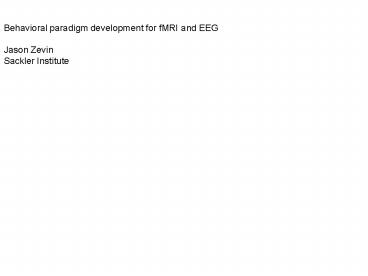Behavioral paradigm development for fMRI and EEG - PowerPoint PPT Presentation
1 / 33
Title:
Behavioral paradigm development for fMRI and EEG
Description:
Behavioral paradigm development for fMRI and EEG Jason Zevin Sackler Institute 256-Channel Geodesic Sensor Net ERPs EEG is averaged Time locked to a stimulus event ... – PowerPoint PPT presentation
Number of Views:69
Avg rating:3.0/5.0
Title: Behavioral paradigm development for fMRI and EEG
1
Behavioral paradigm development for fMRI and
EEG Jason Zevin Sackler Institute
2
Whats your problem?
3
Whats your problem? Clinical Does this
treatment alleviate a particular
symptom? Translational Is activity in this
region related to some feature of a
disorder/disease? Basic How does the brain
accomplish some function?
4
Whats your problem? Are you interested in a
particular region or network? Are you interested
in a particular behavior or function? Are you
interested in a particular population? Do you
care more about spatial or temporal resolution?
5
Different approaches have different
strengths/weaknesses, and are suited to different
kinds of problems. Electrophysiology (EEG) -
high temporal resolution - low spatial
resolution Analysis approaches - event related
potentials (ERPs) - topographic/source analysis
- continuous EEG
6
Different approaches have different
strengths/weaknesses, and are suited to different
kinds of problems. fMRI - low temporal
resolution - high spatial resolution Analysis
approaches - block designs - event-related
designs - correlation analyses - fancy stuff we
wont have time for
7
EEG
8
256-Channel Geodesic Sensor Net
9
EEG Signals
10
ERPs
- EEG is averaged
- Time locked to a stimulus event
- May also be averaged to a response event
(Response Potential) - Increases signal-to-noise
11
(No Transcript)
12
Development Print Processingin the first 200
milliseconds
Maurer et al. (2007)
13
- Whats actually being measured
- Current related to local field potentials in
cortex - Measurements are taken at the scalp, though
14
Locating activity can be tricky! Orientation
plays a role in what you see at the scalp
Graphics from http//www.mrc-cbu.cam.ac.uk/EEG/im
g/Physiological_basis_EEG.gif http//ww2.heartands
troke.ca/images/english/english_brain.jpg
15
The Inverse problem
16
So, whats the upside?
- A more direct measure of neural activity.
- Lets you look at neat stuff like oscillation
frequency
Figures from Wikipedia entry on EEG, of all places
17
Figure from Klimesch, W. (1999) EEG alpha and
theta oscillations reflect cognitive and memory
performance A review and analysis, Brain
Research Reviews, Volume 29,169-195.
18
- Temporal resolution allows fine-grained
inferences about the timing of neural events.
Molholm, S., Ritter, W., Murray, M.M., Javitt,
D.C., Schroeder,C.E., and Foxe, J.J. (2002)
Multisensory auditory-visual interactions during
early sensory processing in humans a
high-density electrical mapping study, Cognitive
Brain Research, 14, 115-128.
19
Some considerations for designing EEG
studies How important is spatial resolution?
Maybe the process you care about is related to a
general brain state, e.g. a stage of sleep.
20
Some considerations for designing EEG
studies Can you get enough data to do ERPs?
(typically 100 trials) Interestingly, kids and
infants, with their thin skulls and little heads,
give better EEG data and need fewer trials (but
they wiggle around more).
21
Some considerations for designing EEG
studies How important is temporal resolution?
Here, the argument that multisensory integration
happens early depends on rapid responses very
short stimuli. But what if your stimuli are
naturally long, or vary in duration?
22
fMRI
23
Ill skip over the basics, because theyve been
covered earlier. But lets think about time.
24
Block designs can maximize power.
response to a single brief stimulus activation
intervals summed up HRFs from activations (ada
pted from the afni regression tutorial)
25
Why would you ever sacrifice power?
26
(audience participation)
27
Slow event-related designs
Stimulus (Neural)
HRF
Predicted Data
?
You can recover the HRF nicely, but you dont get
much data.
http//www.columbia.edu/cu/psychology/tor/
28
Fast event related designs without jitter
Stimulus (Neural)
HRF
Predicted Data
Lots of data, but no idea where its coming from
in time.
http//www.columbia.edu/cu/psychology/tor/
29
Lets get (sort of) random.
Stimulus (Neural)
HRF
Predicted Data
A little randomness in the timing of events
permits better recovery of hemodynamic responses,
with relatively rapid events. Still nowhere
close to the temporal resolution of EEG.
http//www.columbia.edu/cu/psychology/tor/
30
You dont have to get super fancy, though, to see
interesting things. In this study, Singer et al.
administered shocks to women and their partners.
Even a slow, event related design shows
interesting overlap between getting shocked and
watching your honey get shocked. They also took
measures of empathy using paper and pencil
outside the scanner.
31
These correlations are probably bogus (we can
talk about it if theres time). BUT, the
principle of measuring some behavioral trait and
relating it to brain responses is sound. To do a
study like this you probably want a very powerful
design (or stimulus) in order to be sure youre
driving activity in the regions of interest.
32
But you might want to do something subtler with
timing Here, the authors (including
next weeks lecturer) wanted to measure the
effect of context on responses to ambiguous
faces. They used temporal jitter to separate
activity due to the context out from activity
related to seeing the face.
33
Some considerations for designing fMRI
studies Do you want power or subtlety? -
how much time do you have to collect data? (kids,
patients sometimes kinda hate being in the
scanner) - are you trying to characterize the
function of a region/network, or relate activity
in some well-characterized region to a population
variable? Does dealing with the timing of
stimulus presentation to get a nice HRF make your
experiment awkward? Slow? Whats the impact on
behavior? (This happens in EEG, too.)































